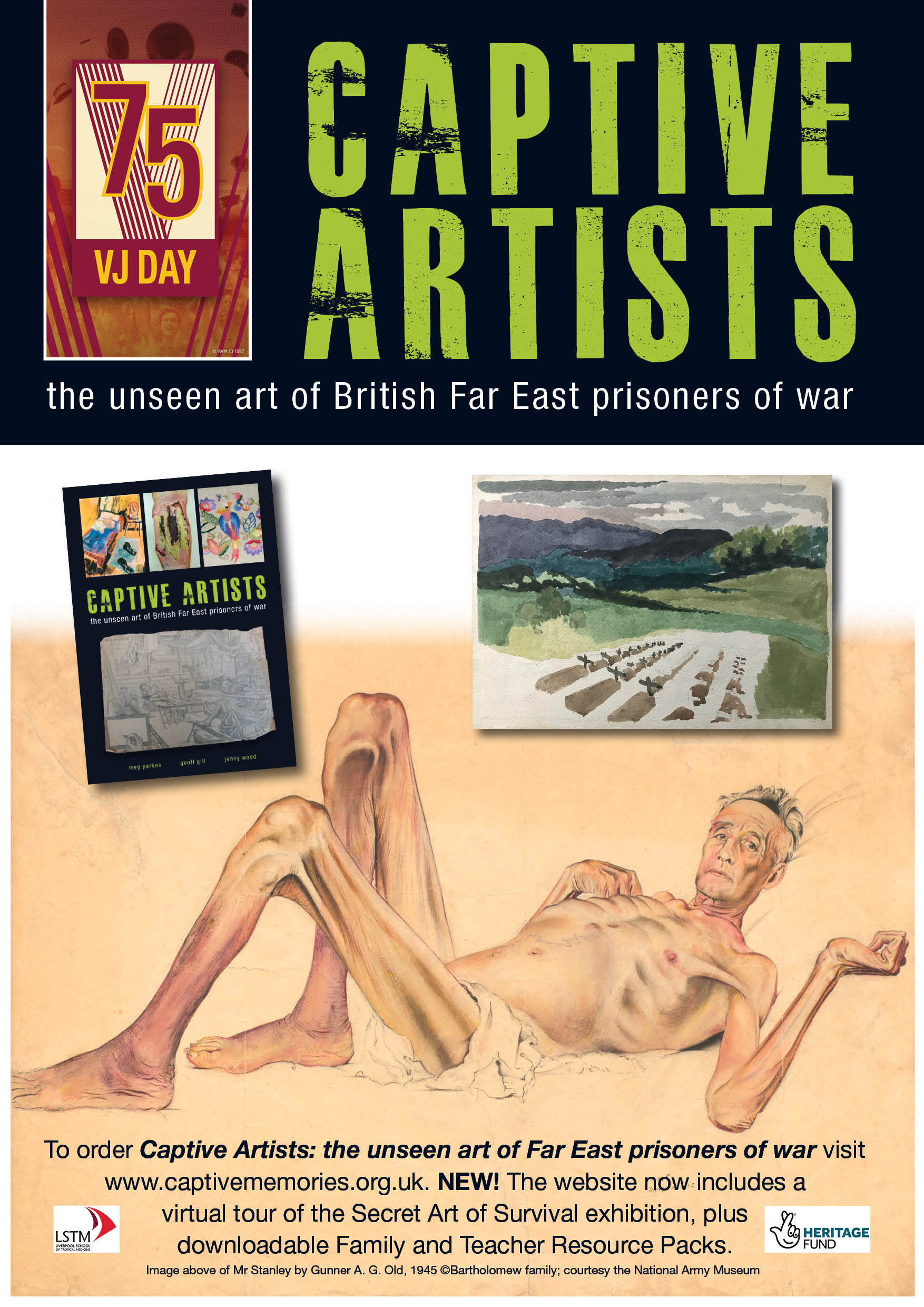On 7 October 1945 the SS Corfu docked in Southampton, the first of many ships to bring almost 40,000 former Far East Prisoners of War back to the UK, after years of privation and suffering in South East Asia during the Second World War.
75 years on, this website seeks to pay tribute to the courage and fortitude of those survivors and to honour the memory of all those who never returned home and still remain somewhere in South East Asia.
We must not forget them.
Roger Townsend, Hon. Director


REUNION DINNER
No schoolboy, relishing his country’s glory,
Shall read our victory there. It has no name,
No statesman cheered the news,
or full-page story
Roused in the public bars a toast to fame.
No classic ode commends, or sculpted face
Peers from a monument to those who fell.
Even our movements tactically disgrace
the paper-battles soldiers love so well,
And friends avoid, with genuine regret,
Mentioning days they’d like us to forget.
Dearer for us to know – as dear to those
Defeated, sore afflicted companies
Who share no common glory – that from these
Grievous dishonours only honour grows.
Lt John Durnford RA
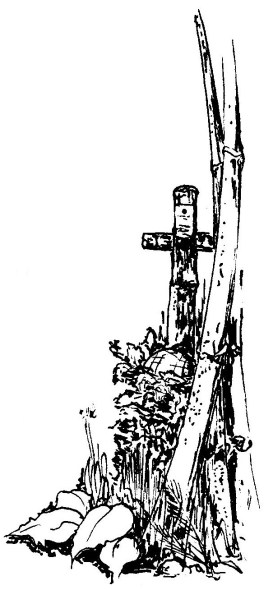
Stan Durnford, published in A Form of Consolation Poems 1942-1945 (1984)
When I became an Argyll a visit to the Regimental Museum was an important part of the induction as a young officer. One particular artefact caught my attention; the bagpipes which Eric Moss took with him into prison camp in 1942 and which for some reason he was allowed to keep for the duration of the war, although the original bag rotted in the conditions and he had to manufacture replacements from whatever materials he could scrounge. The museum, like the Battalion history, focused on the 2nd Battalion's fighting withdrawal, but it is sobering to recall that while 244 men lost their lives in action, of the almost 400 men taken prisoner in the course of the campaign, another 184 died as prisoners of war. One thing that did not die was the regimental spirit and individual determination, courage and comradeship of the Battalion. Symbolic of the spirit which sustained the men for those long years as prisoners of war, is the story of Orderly Quartermaster Sergeant Aitken, who when release came 'exactly reported to the commanding officer of four years before, the state of the Regiment, for he had secreted with him and kept up to date the official regimental roll book'.
I write from the perspective of a single regiment, but it is clear to me that an Army's reputation depends as much on the actions, conduct , discipline and behaviour of its officers and soldiers in the less good, or the downright bad days, as it does on performance on the good days. Indeed the unquenchable will, not only to survive but to prevail, shown by those many men of many regiments held prisoner by the Japanese in all parts of the Far East, in unimaginable conditions of privation, cruelty and inhumanity, is an example for us to ponder and commemorate.
Many former Prisoners of War tried to forget their experiences; some would never be able to do so and would find their lives afflicted to a greater or lesser effect; but on this 75th anniversary of the return of the first of the Far East Prisoners of War to Britain none of us should forget what they endured and the courage and integrity of spirit and discipline which they showed during their time of captivity.
Lieutenant-General Sir Andrew Graham C.B., C.B.E.
Infantry Colonel Commandant and former Colonel of the
Regiment, The Argyll and Sutherland Highlanders and The
Royal Regiment of Scotland
FEPOW75
Histories
The POW camps
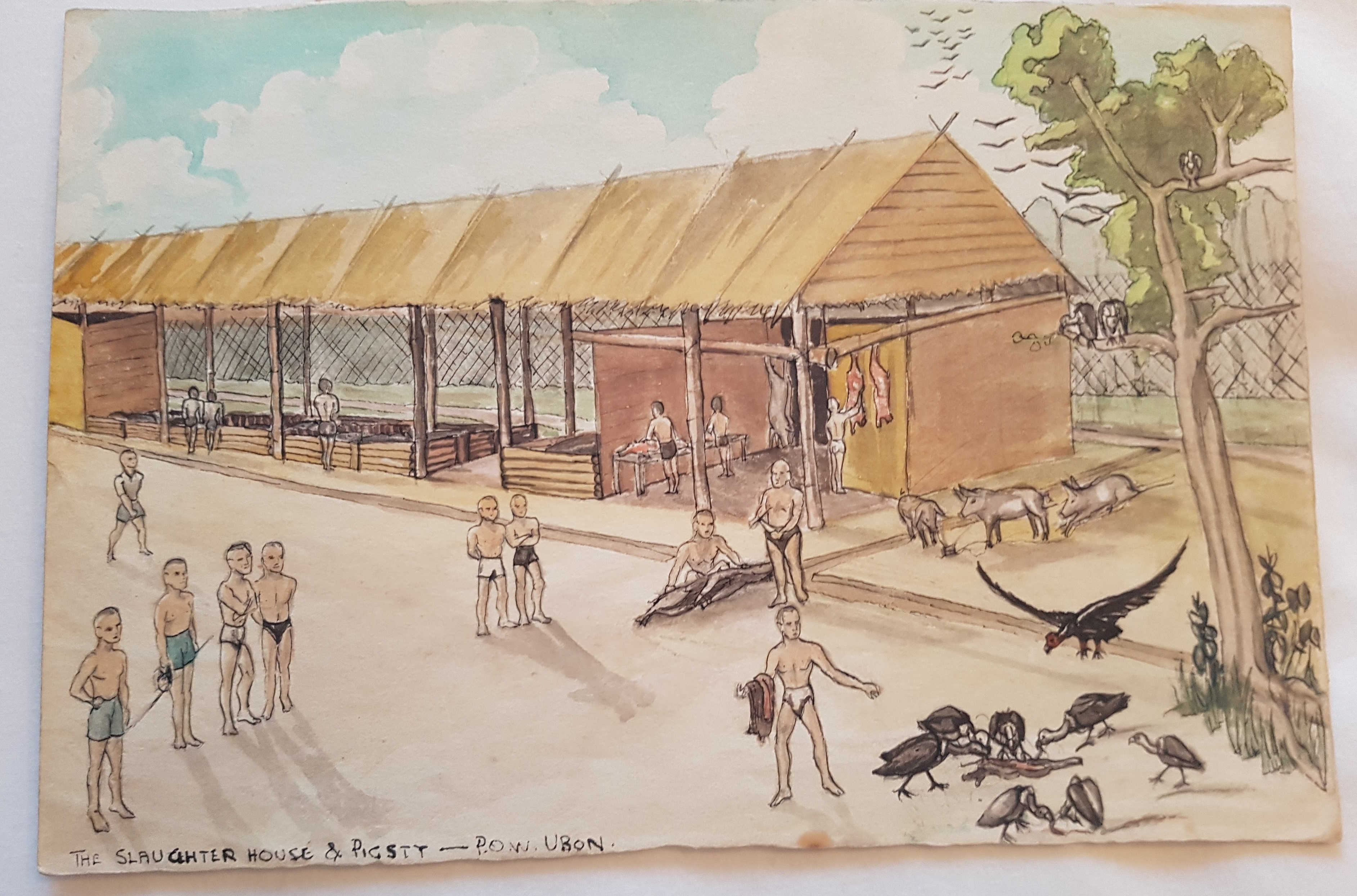
Pvt. Basil Elvin Ferron RAMC Slaughterhouse and pigsty, Ubon POW Camp. Thailand 1945. Courtesy S. Smith
Over 190,000 British and Commonwealth troops were taken prisoner by the Imperial Japanese during the Second World War. For many of those who were held captive in the Far East life was brutally harsh. Many were forced to carry out slave labour under the harshest of conditions, with barely enough food to survive. Most were malnourished and often starving, while many suffered from diseases, such as cholera, dysentery and malaria. Obtaining enough food to survive became their primary concern, with rations shared out equally between them helping to maintain morale inside the camps.
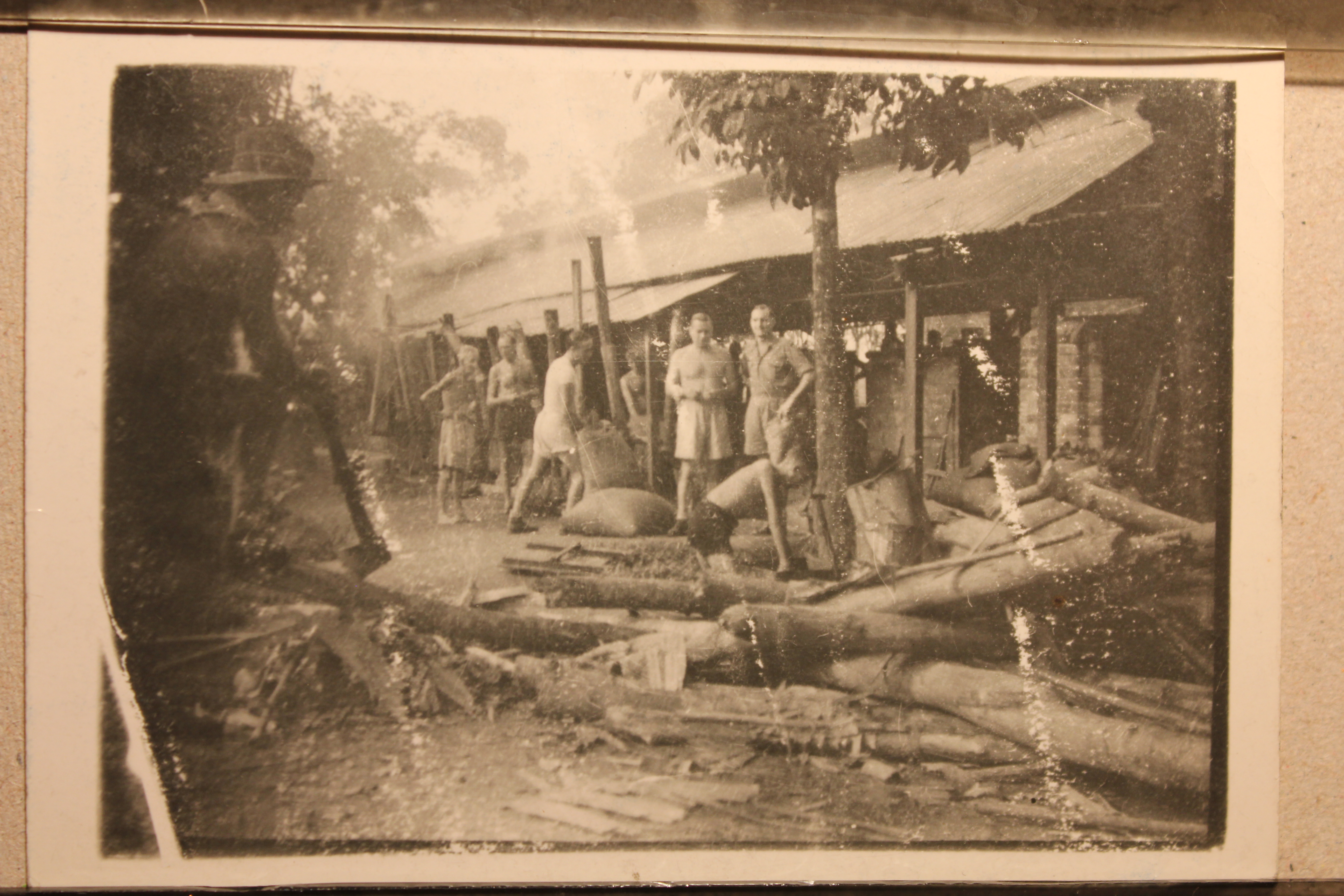
Cpl William George “Bill” Norways 2nd Cambridgeshire Regt, The Cookhouse at Kranji POW Hospital Camp, 1945. © Courtesy the Norways family
Conditions inside the POW camps varied, but for the prisoners on the Thailand Burma ‘Death Railway’, the suffering was terrible. Between 1942 and 1945 over 60,000 British, Commonwealth and Dutch prisoners were forced to work on the railway, enduring the most brutal and harsh conditions imaginable, including long hours of intense heavy labour with minimal food and water, which led to over 16,000 of them perishing.
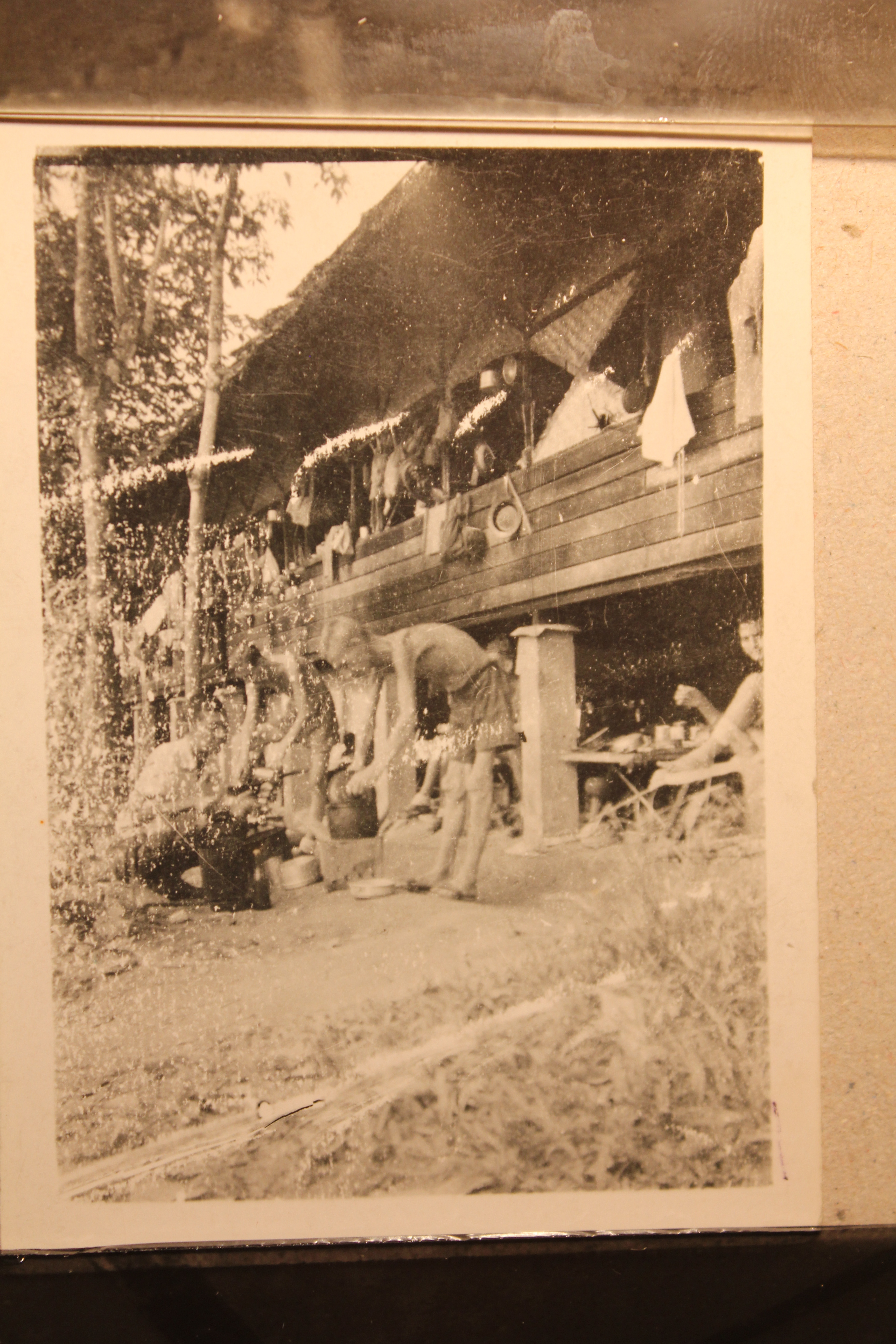
Cpl William George “Bill” Norways 2nd Cambridgeshire Regt, Photograph of the hospital ward at Kranji POW Hospital Camp, 1945. © Courtesy the Norways family
Prisoners were often moved at short notice, often being forced to walk hundreds of miles, from camp to camp. Others travelled by boat or train, with some being taken to Japan, where they were forced to work in mines.
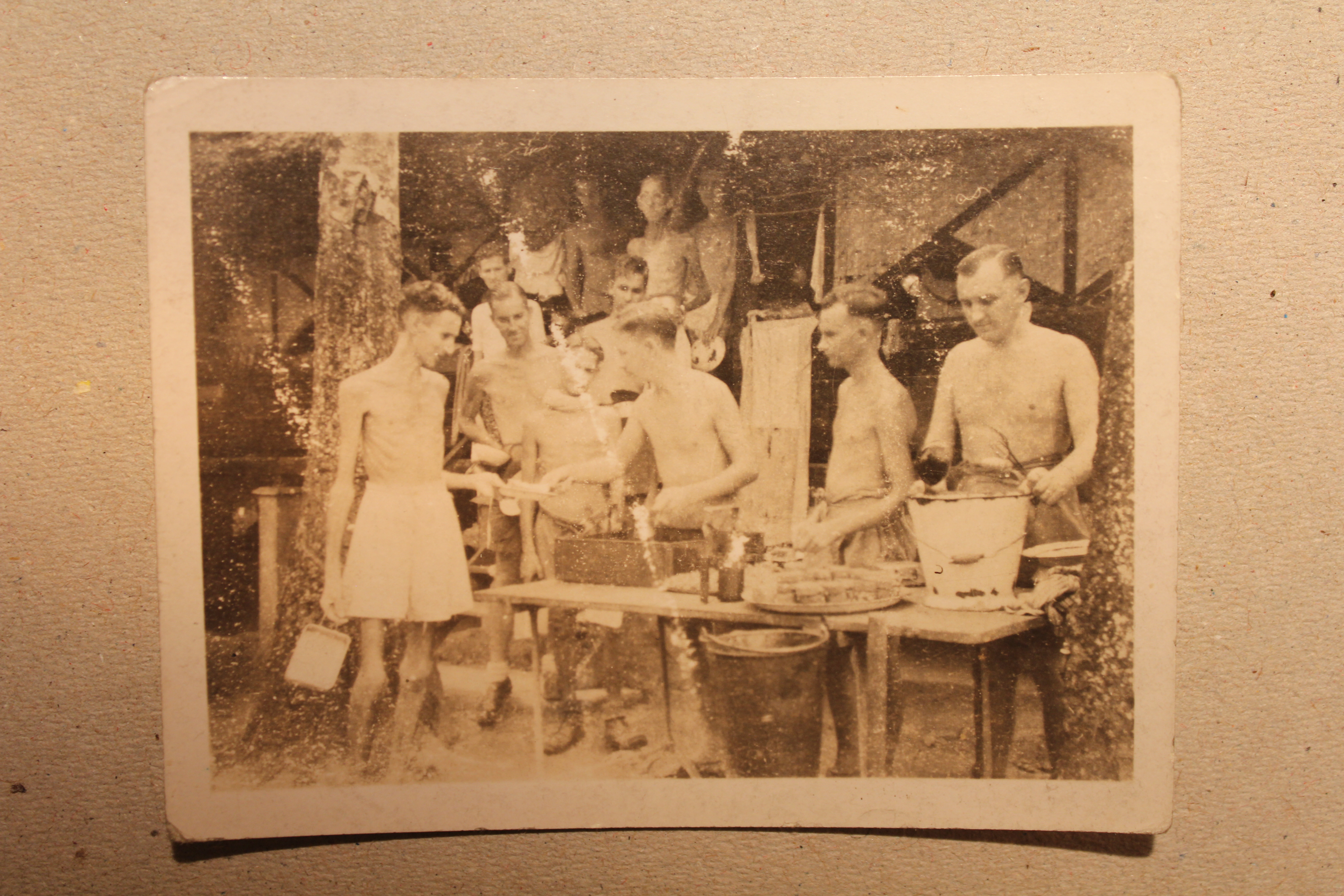
Cpl William George “Bill” Norways 2nd Cambridgeshire Regt, Photograph titled ‘Makan’, taken at Kranji POW Hospital Camp, 1945. © Courtesy the Norways family
What life was like for POWs The story of Taiwan POW campsThe Story of Lt. James Whitham
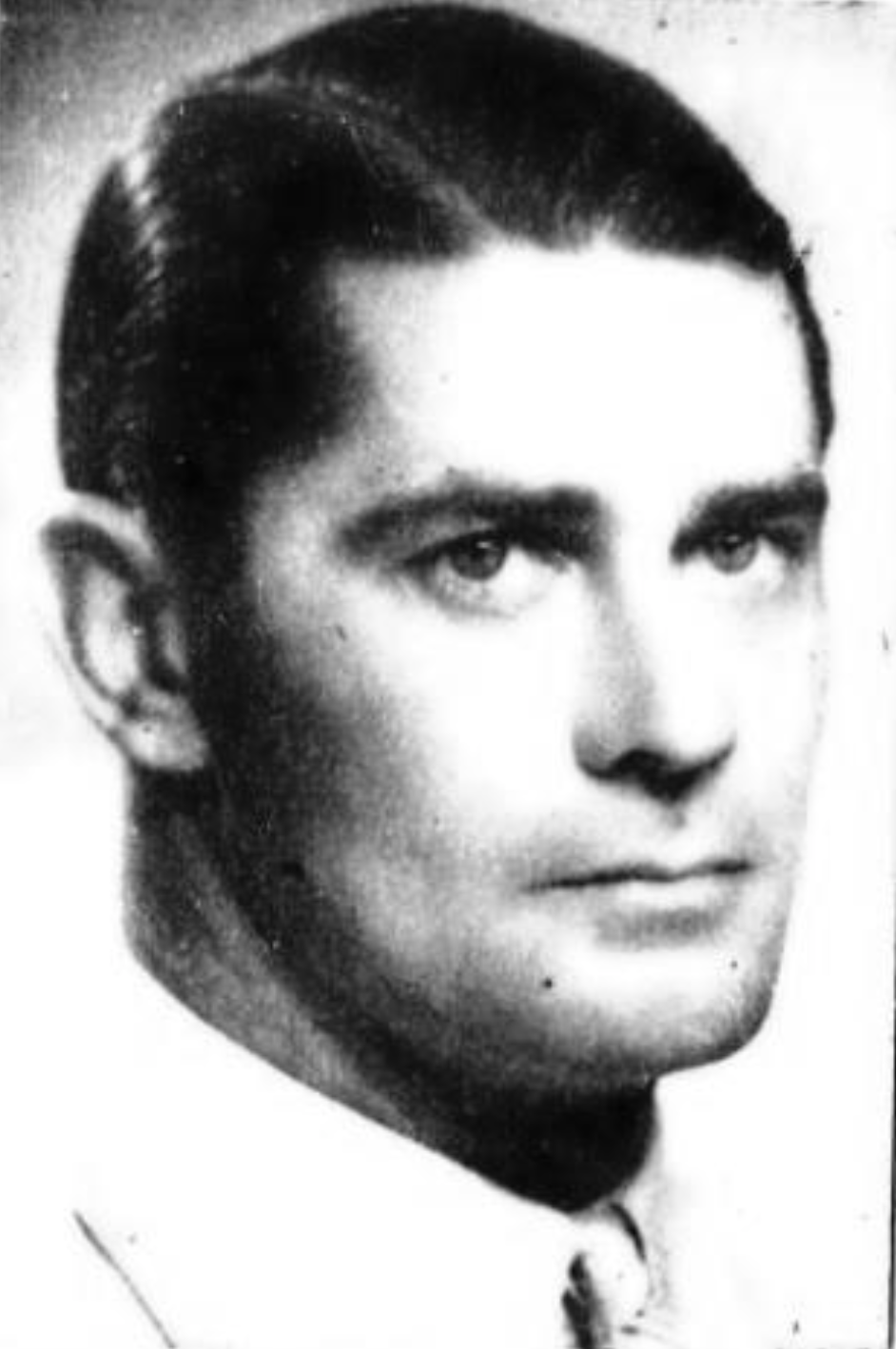
Lt. James Whitham 1907-1942
James Whitham was the son of an East India merchant. He was sent to Sherborne School in 1920 where he had a stellar career, becoming a School Prefect and Head of House. He was in the 1st XV Rugby team in 1923/4/5 and 1st XI Cricket team in 1925. He was a member of the School Gym team in 1923/4 and Captain in 1925. In his last two years he dominated the School athletics and held the record for the 100 yards, Long Jump and Shot Put.
 1923 1st XV
1923 1st XV
He went up to Pembroke College Cambridge, where he won an Athletics ‘Half Blue’ and would almost certainly have been awarded a Rugger ‘Blue’ as a full back, had he not broken his thigh just before the Varsity match.
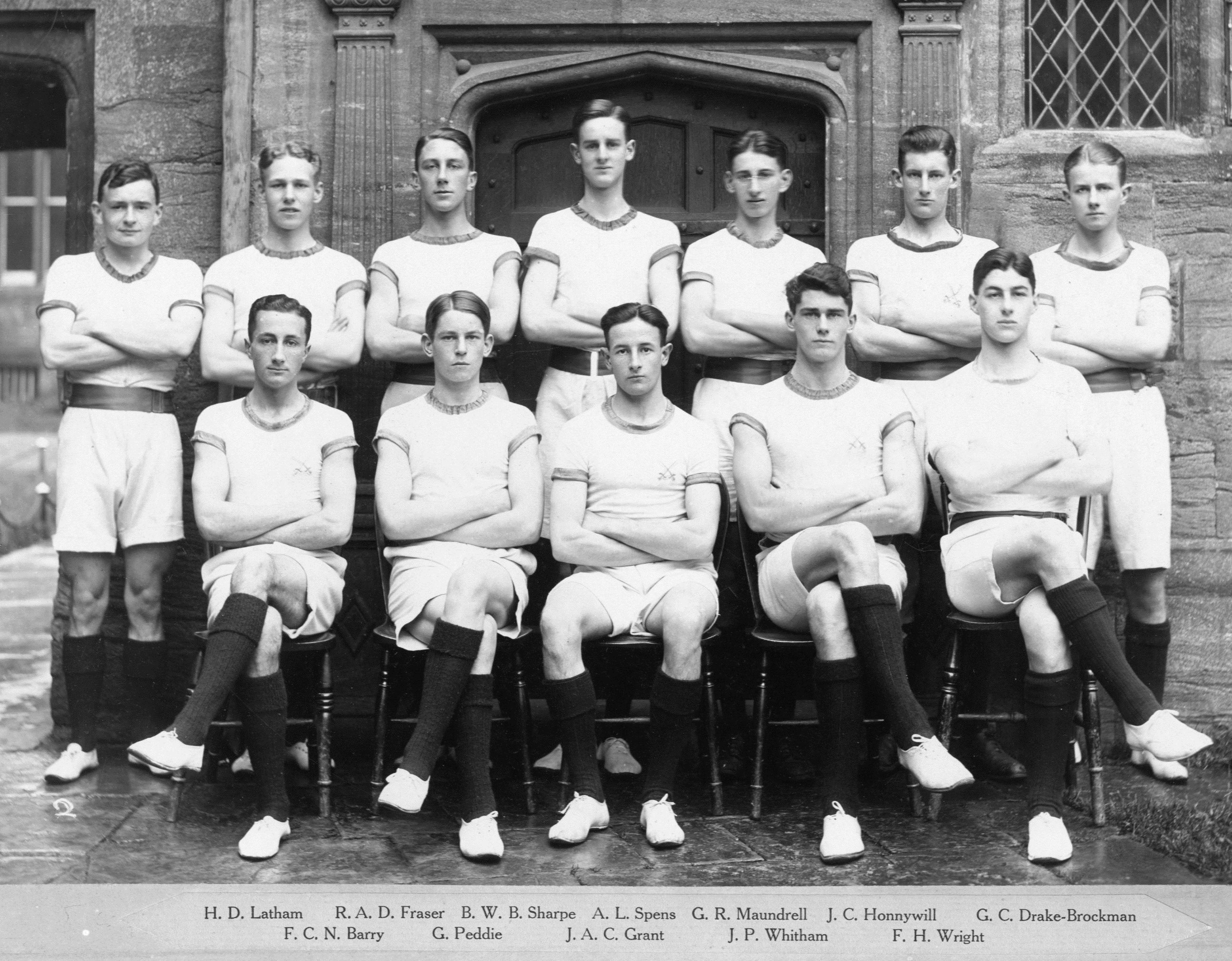 1923 Gym Squad
1923 Gym Squad
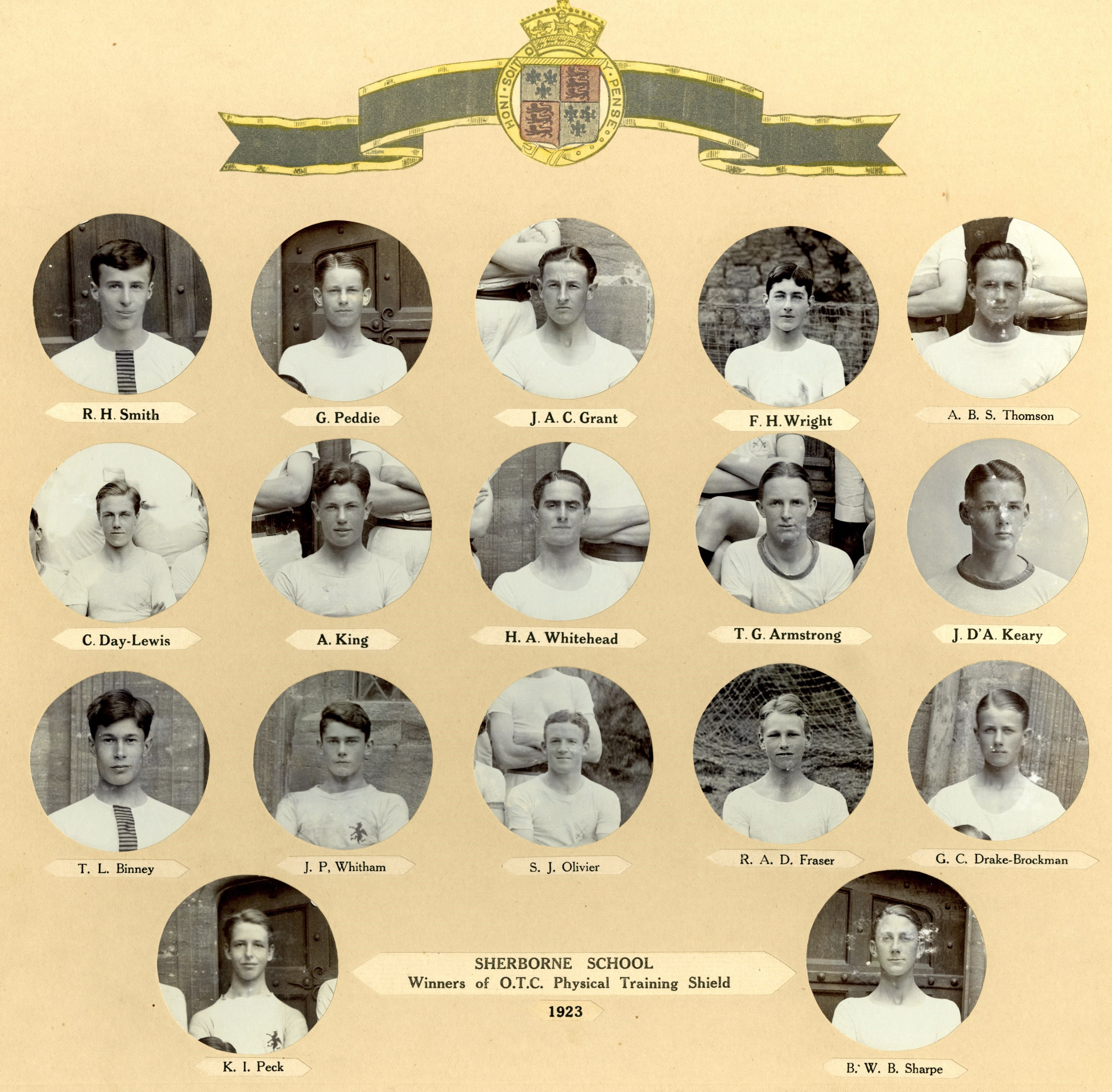 1923, Winners OTC Physical Training Shield
1923, Winners OTC Physical Training Shield
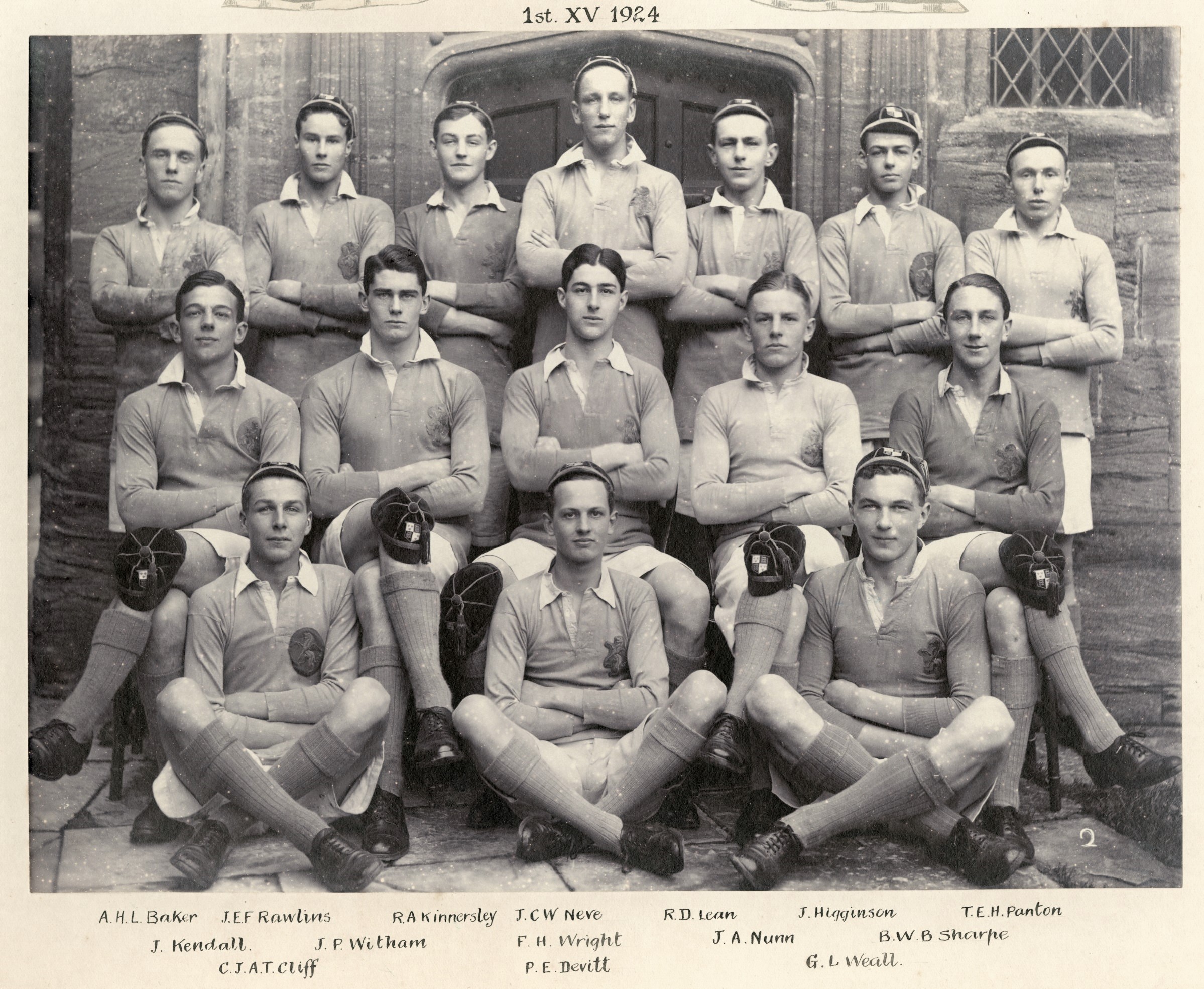 1924 1st XV
1924 1st XV
 1925, 1st XI
1925, 1st XI
After Cambridge James Whitham moved to Hong Kong, where he became the Acting Branch Manager for Sun Life Assurance of Canada. He married Beatrice, from Grand Haven, Michigan and at the end of November 1941 they had a son, Jonathan Glendaye Whitham.
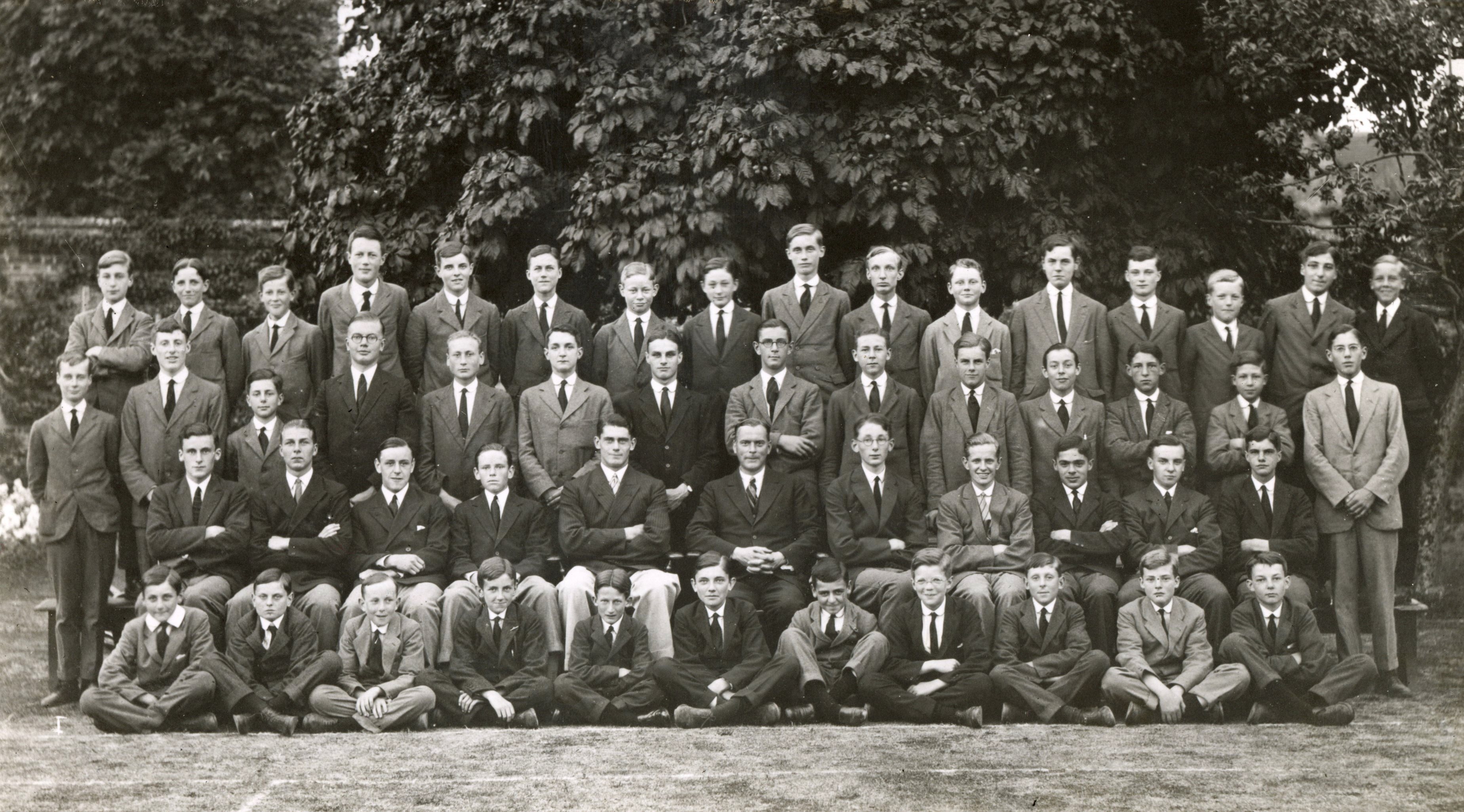 1925, Abbeylands
1925, Abbeylands
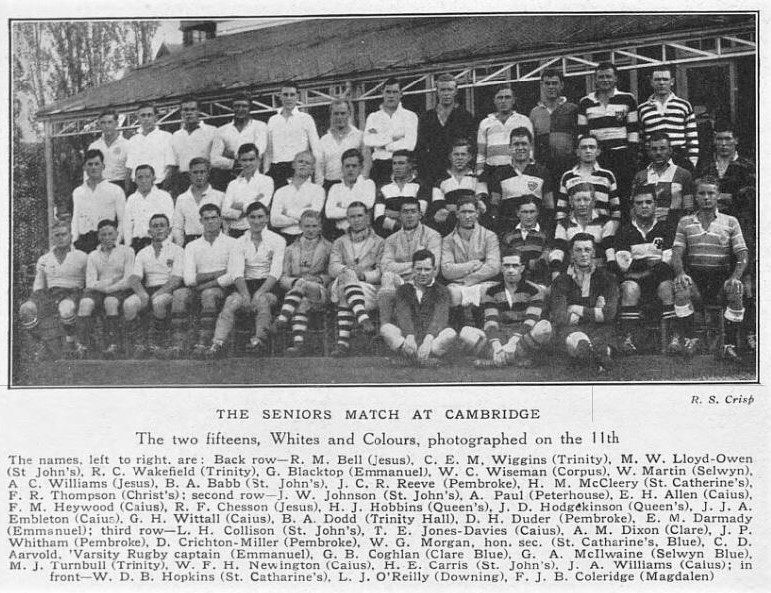 1928, JP Whitham in Cambridge Senior match (The Tatler,
24 October 1928)
1928, JP Whitham in Cambridge Senior match (The Tatler,
24 October 1928)
With the imminent threat from the Japanese James joined the Hong Kong Volunteer Defence Corps. He then transferred to the 1st Bn The Middlesex Regt as a Lieutenant, playing an active part in defending Hong Kong and being wounded in the leg while doing so. He was captured by the Japanese on Christmas Day 1941, but not before he had been able to take Beatrice and her baby son to the supposed safety of the Governor of Stanley Prison. Beatrice had packed clothes for herself and the baby, but her husband had been in such a panic to get her there that she did not have time to do up the cases, so they arrived at the Governor’s house with only the clothes that both she and baby Jonathan were wearing. James went back to resist the invaders, but after the surrender everything in their apartment, including personal possessions and photographs, was looted.
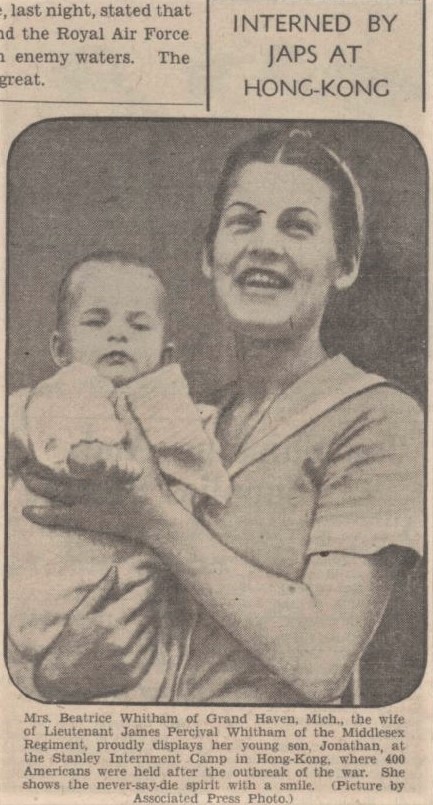 1942, Beatrice & Jonathan Whitham, Stanley Internment
Camp, Hong Kong (Daily Record, 21 Sept 1942)
1942, Beatrice & Jonathan Whitham, Stanley Internment
Camp, Hong Kong (Daily Record, 21 Sept 1942)
On 27 September 1942 James left Hong Kong on the 7,000 ton freighter ‘Lisbon Maru’ bound for Shanghai and Japan: one of 1,816 mainly British prisoners. On board, amongst others, were 311 Royal Navy personnel; 373 of 2 Royal Scots: 358 of 1 Middlesex and 376 Royal Artillery: all crammed into the three forward Holds; while 778 Japanese troops were housed in the aft Holds. Although she was armed, the ‘Lisbon Maru’ displayed no markings other than that of a normal merchant ship.
On 1st October the ‘Lisbon Maru’ was struck in the stern by one of six torpedoes fired from the American submarine USS ‘Grouper’ six miles off the Chinese island of Tung Fushan. The ‘Grouper’ came under attack from enemy planes and patrol boats and departed the scene, but not before noticing the Japanese troops being rescued from the stricken ship by a Destroyer and Freighter, taking the lifeboats and rafts with them, but leaving 25 guards on board, with the crew, with orders to shoot any prisoner who tried to escape. What they did not see however, was that the Japanese guard commander had ordered that the hatches over the forward Holds be battened down and canvassed over.
After spending 24 hours trapped in the Holds, in total darkness, in appalling conditions of filth, disease and malnutrition, with no access to food, water or latrines, it was apparent that the ship was sinking, despite the valiant efforts of RA prisoners who kept up a relentless shift trying to pump out the incoming water with two hand pumps that the Japanese had given them. The senior officer, Lt Col HWM Stewart, ordered Lt Howell of the RASC to make an attempt to break out. One man went with Howell, but was shot dead. Howell reported that there were only 5 guards left on board, so a second attempt was successful enough for the majority of the prisoners to escape, overpower the guards and jump into the water, only to be shot at by surrounding patrol boats, or attacked by sharks.
James Whitham did get off the ship and there are varying accounts of him in the water. In one he is seen hanging on to a hatch cover with Pte O’Donnell, (also of Ist Bn The Middlesex Regt) and apparently trying to give his lifejacket or life belt to O’Donnell, who did not have one. Sometime later he was spotted by another 1MX escapee: Robert Wright. “It was then that I heard someone call my name. It proved to be Lt. Whitham who, completely naked, was hanging on to a flimsy piece of wood.” Wright then swam off to find a lifebelt, but when he returned there was no sign of Jimmy Whitham. There is a suggestion that he was later spotted floating face down in the sea.
828 FEPOW died in the incident, or very shortly thereafter, and of the 988 survivors, 384 were rescued by Chinese fishermen and taken to three nearby islands, where they were treated with great kindness by the Chinese people, before being rounded up by the Japanese and eventually taken on to Shanghai and Japan. Other survivors were rescued from the water by Japanese ships, but of those taken to Japan, more than 200 died during that first winter in their work camps.
*****
Beatrice (Betty) Whitham’s distress at the tragic loss of her husband did not end after the War. She was released in a civilian prisoner exchange with the USA in 1942, but less than three years after her repatriation and moving to the small village of Cobble Hill, British Columbia, her young son Jonathon drowned in a creek near their home.
After marrying John William Humphries and living in India, Beatrice had two more children and eventually came to live in the UK: dying in Hereford on 24 March 2020, aged 103.
RCAT - with appreciation to Major Brian Finch and Tony Banham
Hellships: The Sinking of the Lisbon Maru
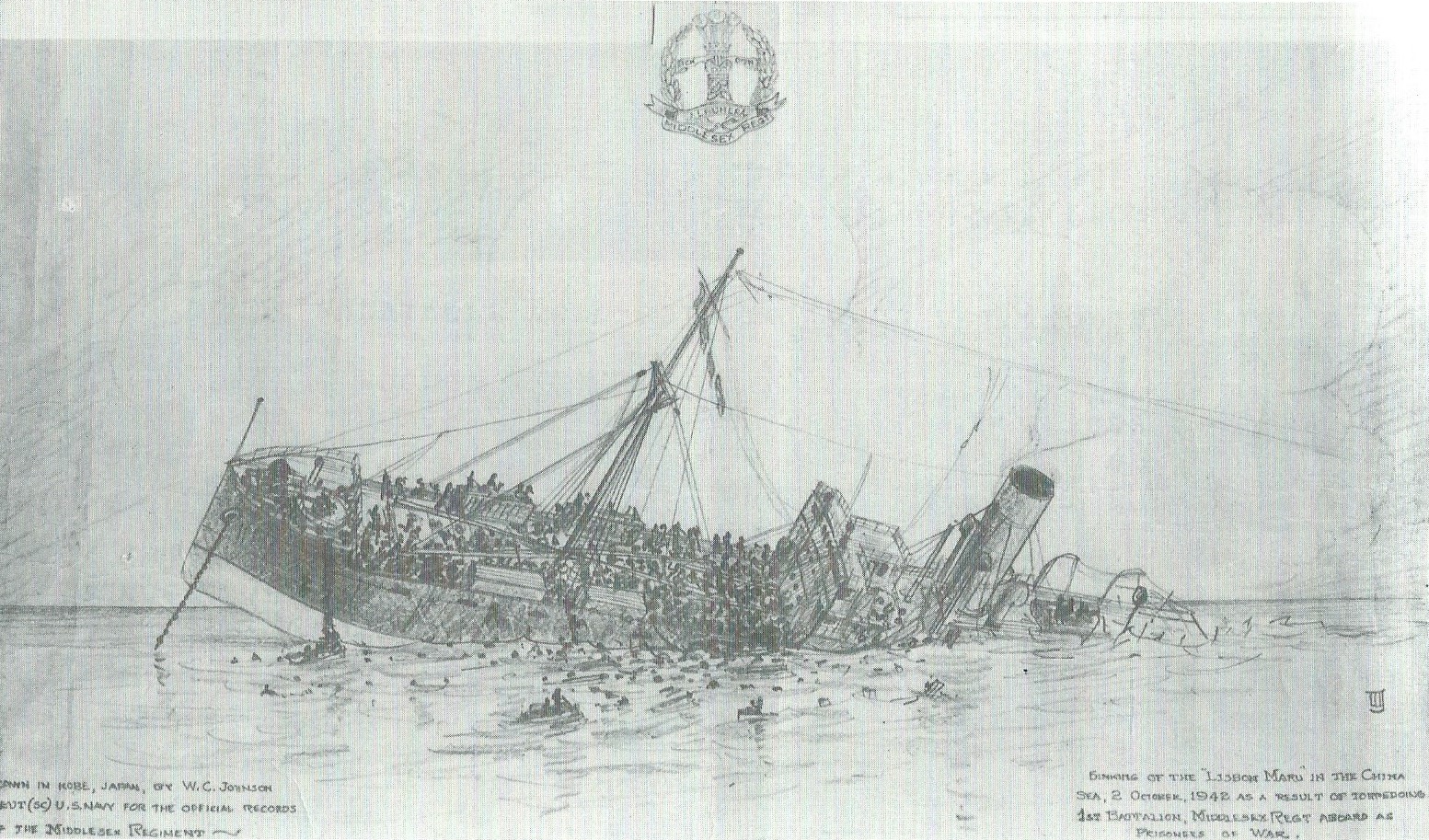
US Navy Supply Officer, Lt. Willard Carroll Johnson USS Canopus. Sketch of sinking of the Lisbon Maru, 2 October 1942, made while at Kobe POW camp, Japan.
On 1st of October 1942, The Lisbon Maru was torpedoed and sunk off the coast of China near Shanghai while carrying prisoners and troops to Japan. Over 800 British prisoners lost their lives.
Further information on the Lisbon Maru & other hellshipsIn Memory Of...
The Poetry of John Durnford

John Durnford
Stanley John Harper Durnford was born on 9 March 1920 in Edinburgh. Educated at Sherborne School from 1934 – 38, he won the English Verse Prize in 1936/37 and 1938; when he also won the Barnes Elocution Prize and the Longmuir English Prize. He edited the School magazine.
He went up to Trinity Hall, Cambridge in 1938 to read History and a promising career beckoned; possibly in education, or the Church. However he was only there a year when War was declared and in September 1939 he quickly joined the Royal Artillery and was posted to Malaya. Leaving Glasgow in March 1941, he made friends on board ship with officers of the Lanarkshire Yeomanry and transferred to that regiment, attached to the Artillery. He arrived in Bombay and after training with the Ghurkas sailed again across the Andaman Sea to Port Swettenham in North Malaya, landing there in August. He fought all the way down the peninsula from Kedah on the Siamese frontier in December 1941 to the last days of the battle for Singapore, culminating in the fall of that island on 15 February 1942, when out of 130,000 Commonwealth casualties he was one of 38,496 British troops captured by the Japanese. In October he was sent with 21,000 other FEPOW to Siam/Thailand to work on the River Kwai ‘Death’ Railway, in country that contained panther, pythons, rattlesnakes and iguana, where even the Thai villagers were afraid to go. 12,399 FEPOW died there, alongside over 90,000 Asiatic labourers.
John Durnford was in Khanburi camp helping to build that railway, spending a gruelling 12 hour working day where each man was designated a cubic metre of earth or stone to excavate by hand. Unlike in Europe, officers below the rank of Captain were also expected to do manual work and, as a Lieutenant, John endured hardships such as starvation, personal assaults and the epidemic diseases of dysentery, malaria and cholera with minimal medical assistance. He wrote his verse at night and with no electricity he had to write by the light of a lamp made of an old tin filled with coconut oil.
It took some days after VJ Day for news to reach Khanburi, and Durnford was finally liberated on 2 September 1945. Thanks to the efforts of Earl Mountbatten he was one of 1,134 FEPOW repatriated from Rangoon to Southampton on the P & O liner ‘Corfu’: arriving on 8 October: the first of 22 ships carrying FEPOW to dock here. It was during the homeward journey that cable-grams and letters had been received through the Recovered Prisoner-of -War Mail Centre, one of these was from John's fiancée saying she had married someone else. No families or girlfriends were allowed to meet them, but they were greeted on board the ship by General Sir Ronald Adam, the Adjutant General; and by Lord Nathan, the Acting War Minister, who gave each FEPOW a written message of welcome from King George VI and Queen Elizabeth. John Durnford has written poems describing his return to Southampton, which feature here.
On disembarkation John and his fellow FEPOW were kept for two days under canvas on Southampton Common before he was given a rail warrant to return to his parents’ home in Bath, having not seen them for over four years. On returning home many FEPOW were to find that wives had re-married and girlfriends had not waited. All had to acclimatise to relationships that they had not had for four years.
The following year John Durnford married a long time friend Paula Hansford; their son Peter was born in 1947 and their two daughters Sara and Caroline in 1949 and 1950.
*****
In common with many thousands of his fellow FEPOW survivors, the peace was not kind to John Durnford. Although he took a regular commission as a Captain and pilot in the Army Air Corps, the memories of his time as a FEPOW were always fresh and he suffered from bouts of severe depression. Following a breakdown when flying in North Africa in 1952, he was retired from the Army on an 80% invalid pension, rising eventually to 100%.
Still with a deep faith, he initially started to train for the priesthood, and then took a number of jobs. Being unable to settle at any of these he turned to his writing skills resulting in his POW story 'Branch Line to Burma' which was published in 1958 by MacDonald.
The legacy of all these experiences took a heavy toll on John’s personal and family life and his first marriage ended in 1959. He then moved to Bristol, remarried to Belinda a few years later and had another son Tom but sadly this marriage also ended.
John managed to continue writing consistently throughout his life, producing another memoir of his flying years called 'Testudo'. He self-published his poetry 'Immortal Diamond' in 1975 and 'A form of Consolation: Poems from 1942-1945' in 1984. In 1985 some of his poetry was included in a collection titled 'Poems of the Second World War ' published by Dent Everyman's Library in association with The Salamander Oasis Trust .
After another brief marriage in the mid-80s to Sheena, who helped him by collating more of his life story and writings, John Durnford finally retired to his beloved City of Bath where he died on 11th August 1995.
*****
John Durnford’s poem Dedication, written for a reunion of the 18th (East Anglian) Division at the House of Commons on 7 October 1956, forms the cornerstone for FEPOW 75.
Hubert Burton reads three short poems by John Durnford
Reunion Dinner
Southampton
Repatriation
Repatriation
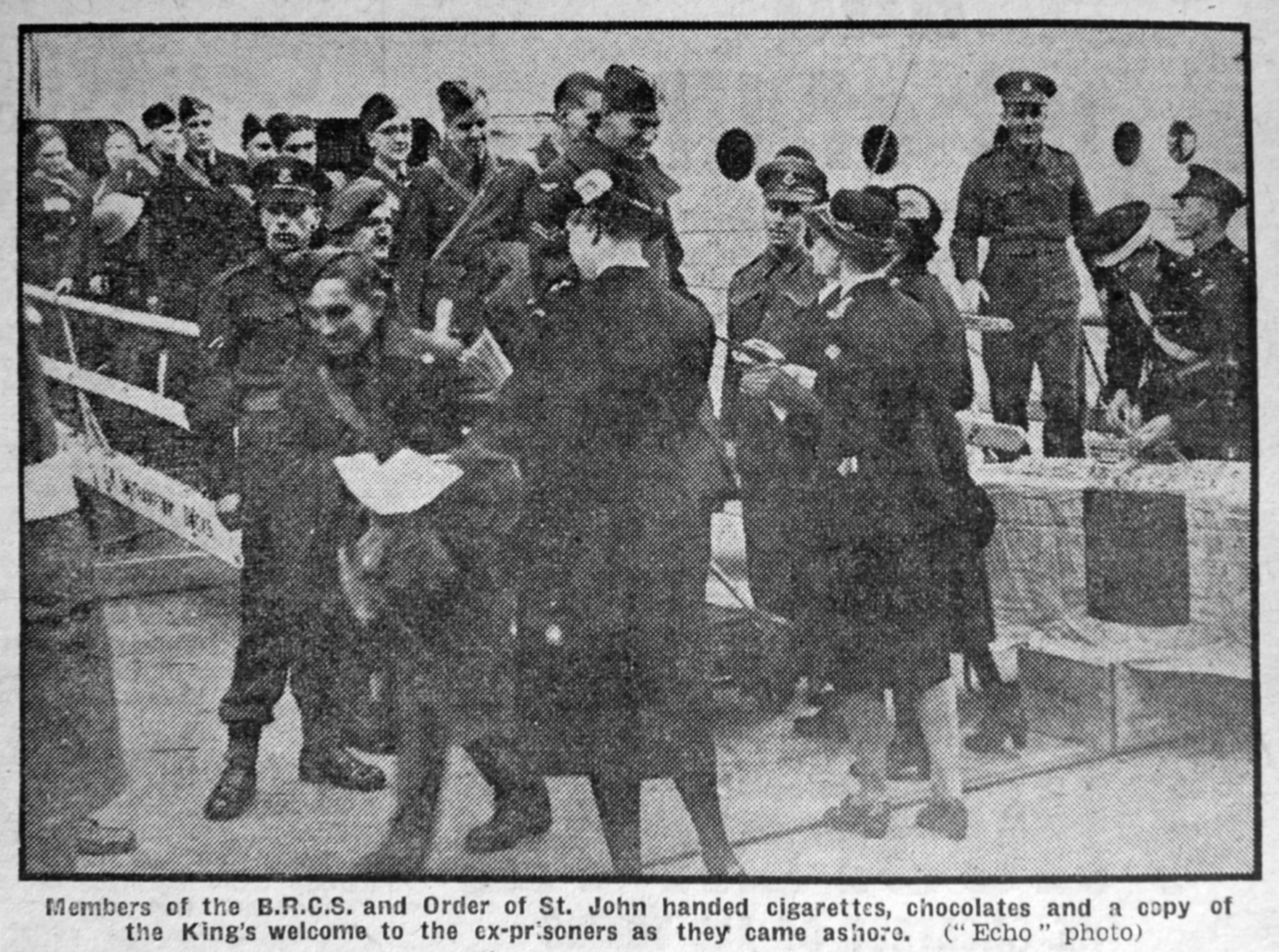
Coming Ashore
List of ships into Southampton
- October 7th - Corfu
- October 17th - Almanzora
- October 18th - Queen Elizabeth
- October 18th - Indrapoera
- October 22nd - Maloja
- October 22nd - Ormonde
- October 22nd - Orion
- October 28th - Chitral
- October 31st - Ile de France
- November 5th - Queen Elizabeth
- November 9th - Highland Monarch
- November 11th - Athlone Castle
- November 14th - Dominion Monarch
- November 18th - Queen Mary
- November 18th - Principessa Giovanna
- November 27th - Queen Elizabeth
- November 28th - Durban Castle
- December 9th - Alcantara
- December 11th - Corfu
- December 11th/12th - Orontes
- December 13th - Arawa
FEPOW75
Links and further reading
Captive Memories
To mark VJ Day75, and as a legacy of the recent highly successful Secret Art of Survival exhibition in Liverpool, largely funded by the Lottery’s Heritage Fund and curated by Victoria Gallery & Museum, the Liverpool School of Tropical Medicine has relaunched its Far East prisoner of war (FEPOW) research website captivememories.org.uk.
Your Memories Page, for anyone connected to this history to leave their memories of a FEPOW relative here.
NEW! Downloadable resources for teachers and families
Teachers' resources featuring FEPOW artwork and histories and designed as an aid to explore FEPOW history with a range of Year Groups.
Family resources – interactive and craft based activities to do with younger members of the family to introduce a FEPOW relative.
CWGC
To mark the 75th anniversary of VJ Day under today’s unusual circumstances, the Commonwealth War Graves Commission created a digital space for people to share their tributes and memories of those who served in the Far East: Wall of Remembrance | CWGC
Books
BRANCH LINE TO BURMA, John Durnford (1958): Friend of Stephen Alexander and fellow poet and founder member of Little Bloomsbury on Kwai
BURMA RAILWAY ARTIST: THE WAR DRAWINGS OF JACK CHALKER, Jack Bridger Chalker (1994): FEPOW artist memoirmemoir of captivity in Singapore and Thailand
‘NOTIFY ALEC RATTRAY…’ PART I, Meg Parkes (2002): FEPOW arNst’s memoir of captivity in Java and Japan
‘…A. A. DUNCAN IS OK’ PART II, Meg Parkes (2003): FEPOW arNst’s memoir of captivity in Java and Japan
BURMA RAILWAY MEDICINE: DISEASE, DEATH & SURVIVAL, Geoff Gill & Meg Parkes (2017): LSTM FEPOW research study
CAPTIVE ARTISTS: THE UNSEEN ART OF BRITISH FAR EAST POW, Meg Parkes, Geoff Gill & Jenny Wood (2019): LSTM FEPOW research study
CAPTIVE MEMORIES: STARVATION, DISEASE AND SURVIVAL, Meg Parkes & Geoff Gill (2015): LSTM FEPOW research study
SPICE ISLAND SLAVES, Leslie John Audus (1996): FEPOW arNst’s memoir of camps in Java and on Haruku and Ambon
SWEET KWAI, RUN SOFTLY, Stephen Alexander (1995): Friend of John Durnford and fellow poet and founder member of Little Bloomsbury on Kwai
TO THE KWAI AND BACK: WAR DRAWINGS 1939-1945, Ronald Searle (2006): FEPOW artist memoir of captivity in Singapore and Thailand
1000 DAYS ON THE RIVER KWAI, Pat Davies and Jean Argles (2017): Lt Col Cary Owtram’s diaries, published 2017
Links
National FEPOW Fellowship Welfare Remembrance Association
The N.F.F.W.R.A. offers practical advice and help to FEPOW and their widows, and comradeship to their descendants.
The Secret Art of Survival
Creativity and ingenuity of British Far East Prisoners of War, 1942 - 1945.
This exhibition was the culmination of over seven years’ research, identifying and locating previously unseen art works. The art had to made secretly and kept hidden by British servicemen in Far East captivity during the Second World War. To date 72 artists have been identified, 40 of whom were featured in the exhibition. It was organised by the Liverpool School of Tropical Medicine (LSTM) in partnership with Victoria Gallery & Museum, and largely funded by the Lottery’s Heritage Fund. It brought together unseen artwork for the first time giving a rare insight into life as Far East Prisoners of War (FEPOW).
During the Second World War, thousands of Allied servicemen became prisoners of the Japanese, known as FEPOW (Far East prisoners of war). They were subjected to a brutal regime of violence, callous neglect and forced labour. The Secret Art of Survival exhibition provides a unique and fascinating glimpse of the battle to survive extreme adversity in wartime and the self-help strategies used by British servicemen, including making art as therapy. Art became the lens through which the artist illuminated the nightmare of disease and death in his midst. There was no other way of recording the neglect - no reporters or Red Cross delegations - just artists who recorded precisely what they wanted the viewer to see. And all done at great risk.
This art, created hurriedly against captors' orders, had to be kept hidden. Over 70 years on, it gives unique insights into the monumental struggle to survive, both physically and mentally, and represents countless and repeated acts of courage. Subject matter includes depictions of the ravages of tropical infections, portraiture, landscape, ingenuity, cartoons and caricatures, theatrical posters, stage sets and wildlife studies.
COFEPOW is a charity devoted to perpetuating the memory of the Far East Prisoners of War. The members are war babies of the men who died in the far east. Never Forgotten - The Story of the Taiwan POW Camps and the men who were interned in them FEPOW! RAF Prisoners of Imperial Japan, 1942 - 1945 The Changi POW Artworks of Des Bettany POW Camps links: Imperial War Museum The Commonwealth War Graves Commission FEPOW history research conferences run by the Researching FEPOW History Group. The RFH Group established the Repatriation Memorials in Southampton and LiverpoolFEPOW75
Acknowledgements
Virtual FEPOW75 Team
Website Curator: Julian McSweeney MA
Website Designer: Ken Rayner
FEPOW Consultant: Meg Parkes MPhil
Communications: Katie Belo dos Santos FITI, MCIL
Communications: Camilla Paul
Physical FEPOW75 Team
Finance: Antony Fanshawe FCA MBA
Finance: Simon Reynier
Administration: Philippa Taman
Southampton City Council: Craig Lintott
Repatriation Commemoration: Walter Tuttlebee OBE
Dancing Man venue: Mandy Lacey-Cross
Contributing Supporters
Matt Ankers, Dr Tony Banham, Keith Bettany, Cllr. Sue Blatchford - Mayor of Southampton, Hubert Burton, Peter Campos PhD, Chris Carnegy, Linda Brouwer Carrigan, COFEPOW, Sears Eldridge, The FEPOW Family, Major Brian Finch - The Middlesex Regiment, Lady Ann Foley, Lieutenant-General Sir Andrew Graham C.B., C.B.E. Infantry Colonel Commandant and former Colonel of the Regiment, The Argyll and Sutherland Highlanders and The Royal Regiment of Scotland, Richard Hutchinson, Joyce Lewis, Megan Maltby - Commonwealth War Graves Commission, Captain James Ramsay - Adj., The Black Watch, 3rd Battalion, The Royal Regiment of Scotland, Lieutenant-General Sir William Rollo K.C.B., C.B.E. - Blues and Royals, Reverend Pauline Simpson - NFFWRA, Colour Sergeant Alastair Tripney - Pipe Major, The Black Watch, 3rd Battalion, The Royal Regiment of, Scotland Pipes and Drums, Jonathan de Sausmarez, Warner Goodman LLP, Corporal Christopher Watt - The Black Watch, 3rd Battalion, Royal Regiment of Scotland Pipes and Drums, Anthony Wilder


